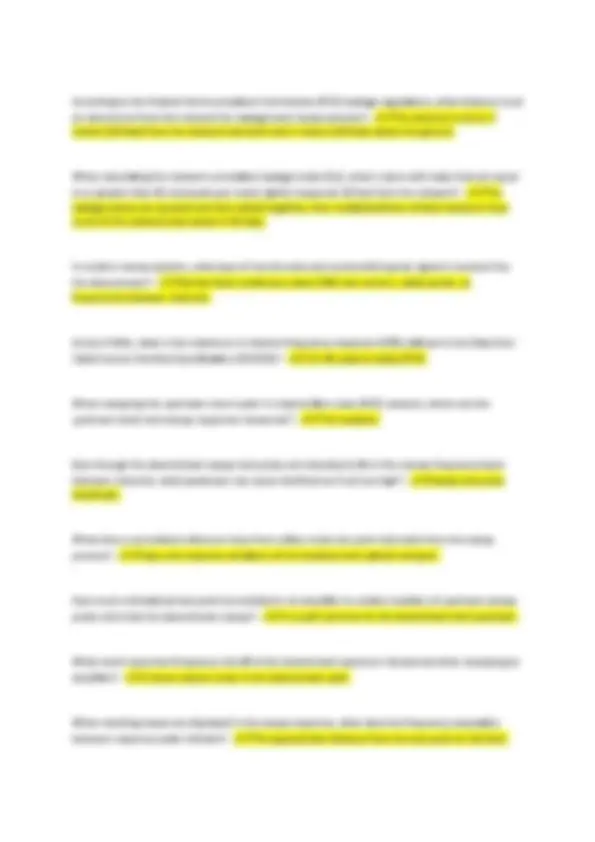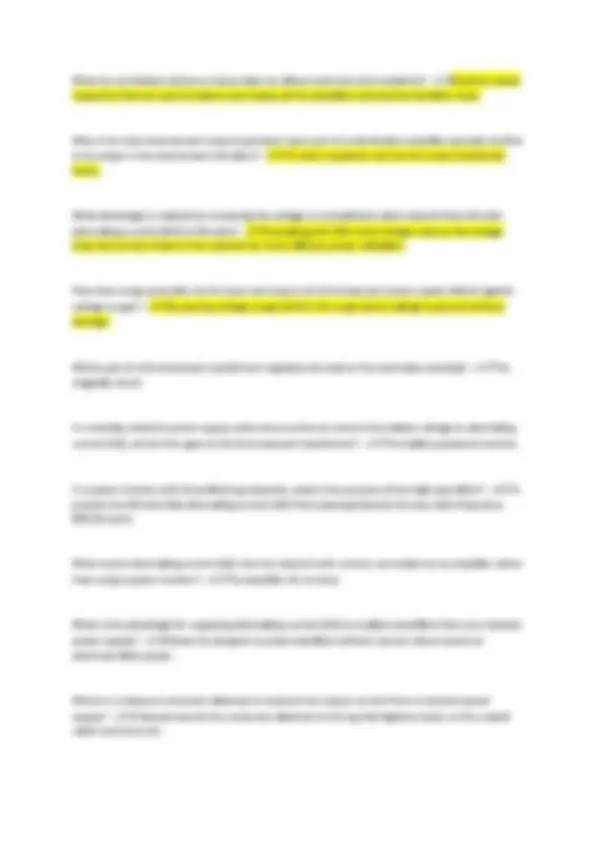









Study with the several resources on Docsity

Earn points by helping other students or get them with a premium plan


Prepare for your exams
Study with the several resources on Docsity

Earn points to download
Earn points by helping other students or get them with a premium plan
Community
Ask the community for help and clear up your study doubts
Discover the best universities in your country according to Docsity users
Free resources
Download our free guides on studying techniques, anxiety management strategies, and thesis advice from Docsity tutors
In the tree-and-branch architecture, how is the downstream signal from the trunk fed to the distribution branches? - ✔✔Within each trunk amplifier, a portion of the downstream is fed to a bridger amplifier to boost the signal before being split and routed to the distribution branches. What is a common solution when congestion from modem activity and traffic becomes unacceptable in a hybrid fiber/coax (HFC) network? - ✔✔Node splitting, the subdividing of serving areas into two or more smaller serving areas. What technologies are defined in DOCSIS 4.0 to help sustain the hybrid fiber/coax (HFC) network infrastructure for several more years? - ✔✔Full Duplex DOCSIS (FDX) and Extended Spectrum DOCSIS (ESD).
Typology: Exams
1 / 13

This page cannot be seen from the preview
Don't miss anything!








In the tree-and-branch architecture, how is the downstream signal from the trunk fed to the distribution branches? - ✔✔Within each trunk amplifier, a portion of the downstream is fed to a bridger amplifier to boost the signal before being split and routed to the distribution branches. What is a common solution when congestion from modem activity and traffic becomes unacceptable in a hybrid fiber/coax (HFC) network? - ✔✔Node splitting, the subdividing of serving areas into two or more smaller serving areas. What technologies are defined in DOCSIS 4.0 to help sustain the hybrid fiber/coax (HFC) network infrastructure for several more years? - ✔✔Full Duplex DOCSIS (FDX) and Extended Spectrum DOCSIS (ESD). How can a less-experienced technician identify what non-standard symbols on the network design maps represent? - ✔✔The legend at the bottom of the network design map that defines the map symbols, cable types, and amplifier data. What is the RF distribution tap value indicated on the tap face plate by a sticker or number stamped into the housing? - ✔✔The signal loss between the tap downstream input port and the tap ports. How can a distribution amplifier be identified in the network or on a network design map? - ✔✔The distribution amplifier has multiple downstream outputs. What is spliced into the hardline coaxial cable to combine the AC power with the transported RF signal in a hybrid fiber/coax (HFC) network? - ✔✔A power inserter. What test instrument sends out a test signal and displays any reflections caused by impedance mismatches in the cable that are characteristic of cable faults? - ✔✔Time domain reflectometer (TDR)
What should you be looking for when analyzing the network design maps to troubleshoot a problem? - ✔✔The device common to those customers affected before traveling to make signal status checks. What is required for checking the physical network integrity when maintaining the coaxial cable network? - ✔✔Being observant and performing some minor tasks while engaged in regularly scheduled activities. Which of the following problem(s) are caused by egress from a hybrid fiber/coax (HFC) network? - ✔✔Interference with aeronautical navigation and communication, amateur radio, public service, and cellular communications. What leakage level must be entered in the leakage log? - ✔✔Leaks 20 microvolts per meter (μV/m) or higher measured 10 feet from the cable. Which is a benefit of an aggressive signal leakage policy? - ✔✔Decreased ingress-related service calls. What is done for leak measuring 1.25 microvolts per meter (μV/m) from about 160 feet away from the coaxial cable network? - ✔✔The leak level is likely 20 μV/m or higher when measured 10 feet from the cable and must be fixed and recorded in the leakage log. If the leakage detector indicates there is a leak and displays a reading of 14 microvolts per meter (uV/m) measured at 80 feet from a possible leak source, what is the approximate calculated level of the leak from 10 feet? - ✔✔112 uV/m. When using the triangulation technique to find the source of a leak, why is a dipole antenna used? - ✔✔The dipole antenna is directional and picks up the strongest signal that is at a right angle, or perpendicular to the antenna elements. When trying to find the source of a very strong leakage signal, what should be done? - ✔✔Reduce the sensitivity of the leakage detector or even remove the antenna and allow the connector alone to pick up the leakage signal. When troubleshooting signal leakage in the drop system, what does it mean if all signs of signal leakage disappear when the ground block is disconnected and terminated on the side connected to the customer premises? - ✔✔Something in the customer premises is the leakage source.
What do normalized reference traces taken at a fiber-node test point establish? - ✔✔Baseline sweep responses that are used to balance and sweep all the amplifiers serviced by that fiber-node. Why is the main downstream output/upstream input port of a distribution amplifier typically the first to be swept in the downstream direction? - ✔✔To select equalizers and set the output amplitude levels. What advantage is realized by increasing the voltage in a broadband cable network from 60 volts alternating current (VAC) to 90 volts? - ✔✔Operating with 50% more voltage reduces the voltage drop and current drawn in the network for more efficient power utilization. How does surge protection at the input and output of a ferroresonant power supply defend against voltage surges? - ✔✔By passing voltage surges (within the surge device rating) to ground without damage. Which part of a ferroresonant transformer regulates the load on the secondary winding? - ✔✔The magnetic shunt. In a standby network power supply, what comes online to convert the battery voltage to alternating current (AC), which then goes to the ferroresonant transformer? - ✔✔The battery-powered inverter. In a power inserter with three filtering networks, what is the purpose of the high-pass filter? - ✔✔To prevent the 60 hertz (Hz) alternating current (AC) from passing between the two radio frequency (RF)/AC ports. What inserts alternating current (AC) into the network with a direct connection to an amplifier rather than using a power inserter? - ✔✔The amplifier AC circuitry. What is the advantage for supplying alternating current (AC) to multiple amplifiers from one network power supply? - ✔✔Allows the designer to place amplifiers without concern about access to electrical utility power. Where is a clamp-on ammeter attached to measure the output current from a network power supply? - ✔✔Clamped around the conductor attached to the lug that tightens down on the coaxial cable connector pin.
What is a priority in any standby power supply maintenance program? - ✔✔Battery care. What is the voltage into the second amplifier in cascade, if each amplifier draws 1.5 amps of current, the loop resistance of each section of cable is 1.38 ohms, and the alternating current (AC) source is a 90 volts AC (VAC) network power supply? - ✔✔83.77 VAC. What enables set-top boxes (STB) and Data Over Cable Service Interface Specification (DOCSIS) modems to operate as completely separate systems that operate independent of each other? - ✔✔STB and DOCSIS modems are assigned different upstream channels with dedicated receivers in the headend. What did the 1.1 version of the Data Over Cable Service Interface Specification (DOCSIS) introduce, incorporating solutions for transporting real-time data applications (such as voice traffic) over the cable operator's managed IP network, and doing so with quality comparable to that of the telephone company? - ✔✔PacketCable. Why is 38 MHz typically the highest frequency in the sub-band frequency that is used for upstream modem transmissions? - ✔✔The upper edge of the sub-band frequency spectrum is prone to group delay caused by the diplex filters. What enables the set-top box (STB) upstream carrier to be located below 20 MHz and still be reliably received? - ✔✔The narrow bandwidth and quadrature phase shift keying (QPSK) modulation. What system is a byproduct of the "funneling effect"? - ✔✔A many-to-one system. House amplifiers with a passive return path are used for what type of situation? - ✔✔For situations when long service drops are used and the forward path needs to be amplified but return path amplification is unnecessary. Why does the output level from customer premises equipment (CPE) vary? - ✔✔To compensate for variable amounts of attenuation in the return path of each device. When calculating return path attenuation in the drop system, what is the attenuation loss through the hot-leg of an unbalanced three-way splitter at sub-split frequencies? - ✔✔3.5 dB.
What practice can uncover potential return path problems in the drop system that can be mitigated before entering the network? - ✔✔Prescreening the drop system for ingress or egress. Why is installing high-pass filters (HPF) at the tap on drops without two-way services considered a short-term solution to ingress and impulse noise migrating into the hybrid fiber/coax (HFC) network?
How is laser clipping in the return path characterized on a spectrum analyzer? - ✔✔By an elevated noise floor above 42 MHz after the optical signal has been converted back to RF, typically in the headend. If a return path impairment appears to be caused by impulse noise, why is it a good idea to begin troubleshooting at distribution taps of 17 dB or lower? - ✔✔Low value taps have less isolation between ports and offer less attenuation to ingress and impulse noise coming from an individual drop system. What amplitude level should the output of return amplifiers be adjusted? - ✔✔So that the amplifier gain is equal to the path attenuation that follows the amplifier. What should be checked if a large percentage of set-top boxes (STB) transmit above 55 dBmV, the upper end of the STB transmission level range? - ✔✔The value of the attenuator pad at the input of the STB demodulator. What type of measurement removes any errors attributable to bandwidth and provides an "apples- to-apples" comparison between carriers of differing bandwidths? - ✔✔The constant power per hertz (power/Hz) measurement. Why are RF return channel carriers unusable for aligning return path equipment? - ✔✔RF return channel carriers are of short duration and from multiple sources. Why are 6 MHz and 41 MHz good choices for test carriers when injecting test carriers into a return path spectrum of 5 MHz to 42 MHz? - ✔✔These frequencies are at the edges of the return frequency spectrum and are available. Where should the injected sweep pulses be placed to avoid interference with active return carriers when sweeping the return path? - ✔✔Between active return carriers only if there is adequate space to accommodate the bandwidth of the injected sweep pulses What is reported when the signal level meter (SLM) in a return path alignment system displays the return test carriers as a delta measurement? - ✔✔The calculated difference between the configured input and the received input.
What happens to the data throughput when transitioning from quadrature phase shift keying (QPSK) to 16-QAM (quadrature amplitude modulation) in a channel of the same bandwidth? - ✔✔The data throughput doubles. What access schemes were introduced with advanced Physical (PHY) Layer technologies in DOCSIS 2.0? - ✔✔Advanced time division multiple access (A-TDMA) and synchronous code division multiple access (S-CDMA). In a DOCSIS 3.1 orthogonal frequency division multiple access (OFDMA) upstream channel, the average power of the subcarriers are normalized to what bandwidth? - ✔✔1.6 MHz. Which optical band is used for optical amplifiers due to the attenuation loss and availability of economical optical amplifiers? - ✔✔The C band. What is one limitation of Fabry-Perot (FP) lasers that is eliminated in distributed feedback (DFB) lasers? - ✔✔Side modes. In what applications are avalanche photodiodes (APD) most likely to be used? - ✔✔In fiber-to-the- home (FTTH) architectures where the high attenuation of optical splitters must be overcome. Why is the E band undefined for fiber-optics communications? - ✔✔There is a lot of older fiber-cable still in use that may have unacceptable water-peak attenuation. In the traditional analog return path, what is critical about the upstream optical transmitter? - ✔✔To make sure the RF level into the upstream transmitter is correct. In a traditional analog return, the optical detectors are responsive to the power of the received signal. How does the signal level at the output of the upstream receiver relate to changes to its input power? - ✔✔The signal level at the output of the upstream receiver changes 2 dB for every 1 dB change of received optical power level. Why is using dBmV, a voltage measurement, acceptable to express the power per Hz power allocation across the channel bandwidth? - ✔✔Because a constant 75-ohm impedance is being used.
When aligning the optical return path, what are the ideal characteristics of the test signal injected into the upstream optical transmitter? - ✔✔A noise signal of the same bandwidth to be used for upstream transport. What evolved after the introduction of switched digital video (SDV) illustrated some limitations of legacy hybrid fiber coax (HFC) networks? - ✔✔Distributed access architecture (DAA). What is it necessary in the optical return path to get the most performance from the DOCSIS 3. specification? - ✔✔Some combination of higher transmit power, more sensitive receivers, and lower path loss. The proper calibration of test equipment is necessary to ensure accurate measurements. Calibration must be performed using test equipment and signals whose accuracy is validated and traceable to what agency? - ✔✔The National Institute of Standards and Technology (NIST). Specific test equipment is necessary to complete proof-of-performance (POP) tests in the headend. Which piece of test equipment is used for headend POP measurements? - ✔✔A waveform monitor. Which calibration is acceptable for FCC proof-of-performance (POP) testing? - ✔✔By the manufacturer or approved service center. Why is the use of spreadsheets to detail proof-of-performance test procedures recommended? - ✔✔Because of the calculations required. What must occur in a video signal in order to observe the composite triple beat (CBT) on a spectrum analyzer? - ✔✔The signal must be turned off. The number of field test points for proof-of-performance tests depends on: - ✔✔The number of customers. To minimize the burden on small cable operators, FCC proof-of-performance (POP) testing is required in systems having a minimum of how many customers? - ✔✔ 1000 Where should at least one proof-of-performance test point be located? - ✔✔At the end of the longest cascade.
What do most models of laser light sources use as operational status indicators? - ✔✔Light-emitting diodes (LED). What occurs when a laser light source is used to test fibers? - ✔✔A 2 kHz modulation provides a test signal that allows the fiber under test to be detected by an optical fiber identifier. Which of the following is true regarding optical fiber identifiers? - ✔✔Optical fiber identifiers detect live traffic signals or modulated test signals on an individual optical fiber.